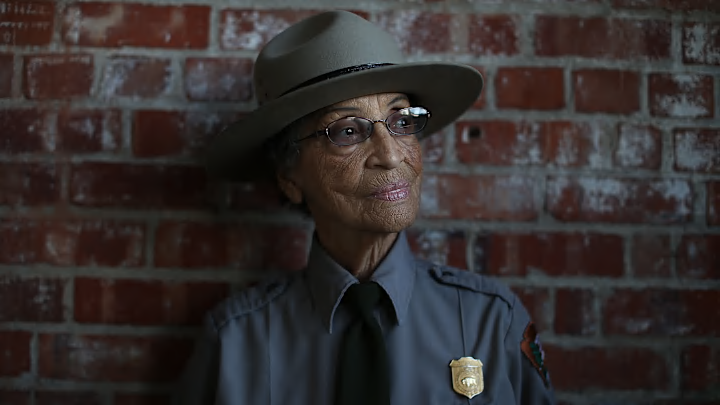When most people think about national parks, they imagine the nation’s most stunning features tucked behind an entrance station—they don’t think about the people who protected the land or fought to make it accessible to the public. Although the first few years of the National Park Service were dominated by male employees, it didn’t take long for women to become irreplaceable members of the national park network. Whether they were recreating in the outdoors, fighting for new designations, or helping to keep the organization working like a well-oiled machine, the following women made significant contributions to National Park Service history.
1. Betty Reid Soskin

When Betty Reid Soskin turned 100 in September 2021, she did more than celebrate a milestone birthday: She became the oldest active national park ranger in the United States. She has worked at the Rosie the Riveter/WWII Home Front National Historic Park in California since 2004. Soskin was 85 when she formally became a ranger; as a part of her job, she shares her own history of segregation with the public, hoping it will allow others to share their stories too.
2. Claire Marie Hodges
Near the end of World War I, many American men were fighting overseas, which created vacancies across U.S. job markets. At this time, Claire Marie Hodges—a long-time lover of Yosemite National Park—learned about a park ranger vacancy and applied for the position. She became Yosemite National Park’s first female ranger in 1918, spending most of her time patrolling on horseback. According to some sources, this made her first woman ranger in the national park system.
3. Helene Wilson
In 1918, at the same time that Claire Marie Hodges was writing history in Yosemite National Park, Helene Wilson was forging her own path in Mount Rainier National Park. Just a few weeks after Hodges began her job as a ranger, Wilson began working at Mount Rainier's entrance station, where she helped issue permits and direct traffic. It’s likely that Wilson was the National Park Service’s second woman ranger.
4. Florence Bascom

Acadia National Park’s geology gives scientists significant insight into Earth’s history. In the late 19th century, Florence Bascom became the first woman geologist to work on Mount Desert Island in Acadia National Park, where she made significant scientific contributions to the community. She was also one of the first certified women geologists, allowing her to become the first woman to work for the U.S. Geological Survey in 1896. Her work helped pave the way for others, too: In the early 20th century, Bascom helped train most of the country's women geologists.
5. Fran P. Mainella
Fran P. Mainella was the first woman to work as the director of the National Park Service. When she assumed the position in 2001, she’d already had 30 years of park experience under her belt. She served as director for just over five years; during her tenure, Mainella supervised over 150 different parks and historical sites. She also had a hand in the development of new national park programs and job opportunities.
6. Carrie Williams Qisiliaq Uhl
Carrie Williams Qisiliaq Uhl was born into the Sisualik settlement in the Cape Krusenstern in Alaska in 1922. She hunted and gathered to support herself, developing a deep respect for the Earth’s resources. She and her husband, William Uhl, published a number of different pieces that helped designate and protect the Noatak National Preserve and Cake Krusenstern National Monument.
7. Minerva Hamilton Hoyt

Minerva Hamilton Hoyt campaigned to preserve what's now Joshua Tree National Park. She recognized how sensitive desert ecosystems are to human disturbances, and hoped to protect Joshua Tree with a national park designation. With her help, Joshua Tree first became a National Monument in 1936. It was formally turned into a National Park in 1994. In 2012, a peak in the park was named Mount Minerva Hoyt in her honor.
8. Marjory Stoneman Douglas
Marjory Stoneman Douglas recognized the ecological importance of the Everglades before Congress did. She witnessed the negative effects of constricting the preserve’s water flow and disrupting local habitats for development. Through her staunch efforts to rally support for what was once seen as a basic swamp, she began changing the way the preserve was perceived. In 1947, Douglas published a book, The Everglades: River of Grass, to catalog the importance of the preserve, ultimately contributing to its re-designation as a National Park.
9. Ynes Mexia
Ynes Mexia started as a botanist 55, quickly becoming one of the field’s most remarkable students after taking her first plant collecting trip in 1925. Although she dealt with financial hardship, mental health difficulties, and a divorce early in her life, she didn’t allow her struggles to impact her work as a conservationist. Over the course of 13 years, she cataloged and documented thousands of different plants, creating an educational database for future students of botany. Mexia also staunchly fought to conserve the planet and recognized the value of ecological habitats like those of the redwood forests; her work helped to pave the way for their designation as a National Monument.
10. Ann Axtell Morris
Ann Axtell Morris was a child when she developed an interest in ancient cultures. In the 1920s, she earned a bachelor’s degree and began working as an archaeologist—despite the fact the field was almost entirely composed of men. Morris predominantly studied ancient ruins in the Southwest, where she worked in national parks like Mesa Verde. She also made significant discoveries in the Canyon de Chelly National Monument.
11. Herma Albertson Baggley
In 1931, Herma Albertson Baggley became Yellowstone’s first permanent woman naturalist. Her background in botany and education helped her educate and guide the public through the park. She also wrote more than 20 articles for the national park and discovered a snake species. The guidebook she co-wrote, Plants of Yellowstone Park, created a greater sense of awareness surrounding the region’s flora and fauna, and is still used today.
